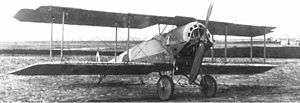Fokker D.III
| Fokker D.III | |
|---|---|
 | |
| Later D.III with balanced ailerons | |
| Role | Fighter |
| Manufacturer | Fokker-Flugzeugwerke |
| Designer | Martin Kreutzer |
| Primary user | Luftstreitkräfte |
| Produced | 210 |
|
| |
The Fokker D.III (Fokker designation M.19) was a German single-seat fighter aircraft of World War I. It was the last Fokker front-line design to use wing warping for roll control as originally designed, before ailerons had been introduced to Fokker combat designs.[1]
Design and development
The M.19 began as an effort to improve the performance of the Fokker D.II (Fokker designation M.17).[2] The M.19 featured the Oberursel U.III 14-cylinder, two-row rotary engine, combined with the two-bay wing cellule of the Fokker D.I.[2] The U.III engine, first used in the Fokker E.IV, required a revised fore-and-aft mount and a strengthened fuselage.[2] The prototype M.19 arrived at Adlershof for testing on 20 July 1916. Idflieg issued a production order for 50 aircraft at that time, followed by orders for an additional 60 aircraft in August and 100 in November. The new aircraft was designated D.III by Idflieg.
Operational history
The first seven production aircraft were delivered on 1 September 1916.[3] On that date, two D.III aircraft were ferried from Armee Flug Park 1 to Jagdstaffel 2 at Bertincourt.[4] Oswald Boelcke received serial 352/16 and obtained seven victories in it between 2 September and 15 September.[5]
While the D.III offered better performance than the D.I and D.II, Boelcke nevertheless found the D.III to be too slow.[6][7] The D.III was plagued by its U.III engine, which wore out quickly and was difficult to manufacture.[8] Low compression resulted in poor performance at altitude[9] and cooling of the rear row of cylinders proved problematic. Moreover, the D.III offered indifferent maneuverability.[10] On Boelcke's recommendation, the D.III was withdrawn from heavily contested sectors of the Western Front, but it continued to serve in quieter sectors.[6]
In early October 1916, evaluation of Fokker's M.21 prototype at Adlershof revealed poor construction and workmanship.[3] In response, Idflieg directed that a production D.III be tested for quality control purposes.[3] In November 1916, serial 369/16 was disassembled and tested to destruction at Adlershof.[11] While the wings proved acceptable, the fuselage and tail surfaces failed to meet specifications.[3][11] Idflieg reprimanded Fokker for his firm's substandard construction practices, but permitted D.III production to continue.[3] The Kogenluft, however, forbade the use of Fokker aircraft for frontline duties.[3]
Fokker built 210 D.III aircraft at its Schwerin factory before production ceased in the spring of 1917. Late production aircraft replaced the wing-warping system with horn-balanced ailerons on the upper wing. Though unsuitable for frontline service, the D.III continued to serve in home defense units until late 1917.[6] In October 1917, Germany supplied 10 D.IIIs to the Netherlands.[12] These aircraft remained in service with the Luchtvaartafdeling until 1921.
Boelcke's D.III, serial 352/16, survived the war to be displayed at the Zeughaus museum in Berlin. The aircraft was destroyed by an Allied bombing raid in 1943.[5]
Operators
Specifications
General characteristics
- Crew: one pilot
- Length: 6.30 m (20 ft 8 in)
- Wingspan: 9.05 m (29 ft 8 in)
- Height: 2.55 m (8 ft 4 in)
- Wing area: 20.0 m2 (215 ft2)
- Empty weight: 430 kg (948 lb)
- Gross weight: 710 kg (1,565 lb)
- Powerplant: 1 × Oberursel U.III, 120 kW (160 hp)
Performance
- Maximum speed: 160 km/h (100 mph)
- Range: 220 km (137 miles)
- Service ceiling: 4,700 m (15,420 ft)
- Rate of climb: 4.8 m/s (940 ft/min)
Armament
References
| Wikimedia Commons has media related to Fokker D.III. |
Notes
- ↑ Wagner, Ray; Nowarra, Heinz (1971). German Combat Planes: A Comprehensive Survey and History of the Development of German Military Aircraft from 1914 to 1945. New York City: Doubleday. p. 63.
- 1 2 3 Gray and Thetford 1962, p. 92.
- 1 2 3 4 5 6 Leaman 2003, p. 23.
- ↑ VanWyngarden 2007, p. 10.
- 1 2 VanWyngarden 2006, p. 76.
- 1 2 3 Weyl 1965, p. 171.
- ↑ Lamberton 1960, p. 120
- ↑ Weyl 1965, pp. 122-123.
- ↑ Weyl 1965, p. 123.
- ↑ Weyl 1965, p. 173.
- 1 2 Weyl 1965, p. 172.
- ↑ Green and Swanborough 1994, p. 221.
- ↑ Woodman 1997, p.3.
Bibliography
- Gray, Peter and Owen Thetford. German Aircraft of the First World War. London: Putnam, 1962. ISBN 0-933852-71-1
- Green, William and Gordon Swanborough. The Complete Book of Fighters. New York: Smithmark, 1994. ISBN 0-8317-3939-8.
- Lamberton, W.M., and E.F. Cheesman. Fighter Aircraft of the 1914-1918 War. Letchworth: Harleyford, 1960. ISBN 0-900435-01-1.
- Leaman, Paul. Fokker Dr.I Triplane: A World War One Legend. Hersham, Surrey, UK: Classic Publications, 2003. ISBN 1-903223-28-8.
- VanWyngarden, Greg. Early German Aces of World War I (Aircraft of the Aces No. 73). Oxford: Osprey Publishing, 2006. ISBN 1-84176-997-5.
- VanWyngarden, Greg. Jagdstaffel 2 Boelcke: Von Richthofen's Mentor (Aviation Elite Units No. 26). Oxford: Osprey Publishing, 2007. ISBN 1-84603-203-2.
- Weyl, A.R. Fokker: The Creative Years. London: Putnam, 1965. ISBN 0-85177-817-8.
- Woodman, Harry. Spandau Guns (Windsock Mini Datafile No.10). Berkhamsted, Herts, UK: Albatros Publications, 1997. ISBN 0-948414-90-1.